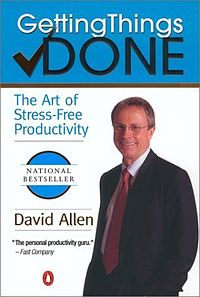This is Week 20 of a Year of Living Productively
This week I tested Getting Things Done. {affiliate link} I put all my tasks into a trusted system and labeled them according to priority, context, time, and energy required. Many of them were associated with a project as well. Scroll to the bottom of last week’s post to see my plan.
How Getting Things Done Saved My Sanity This Week
- Writing everything down gave me peace of mind. I was at a place where I had a lot of things rolling around in my head and it really was a relief to write them all down and then process them.
- A weekly review gave me added peace of mind. For the first time, I looked at IQTell‘s Weekly Review option which has checkboxes for all aspects of it, including considering higher level goals. When I tried GTD many years ago, this was the piece that I was missing.
- Working by context streamlined my work. I was in a low-energy state with iPhone in hand, so I looked up tasks I could do with my phone. Turns out something I dreaded (cleaning up my mangled address book) was easy and enjoyable. I also had lots of tasks that needed doing in our outside office. I realized I was putting those off because I didn’t want to interrupt my flow to go out there. Once I had a nice list of things to accomplish there, I was ready to get to work.
- Made me think about limiting my work to just each project’s next action. As a blogger, I have dozens of ways to improve my blog on my task list. I realized I was trying to work on them all at once instead of focusing on the one with the most impact before moving on to the others.
How Getting Things Done Made Me Crazy This Week
- Didn’t give me a short list of things to do today. Only things you absolutely must do on a certain day are supposed to go on a calendar. For that reason, I didn’t date a task unless it was vitally time sensitive. Within just a few days, I couldn’t stand wading through a long list of tasks, even within priorities or contexts. I have developed a habit of dating tasks I want to at least consider doing on a given day. I started dating them and was fine.
- The mind like water didn’t last. If I write down absolutely everything I want or need to do, I eventually become more stressed. I feel (and rightly so) that there is no way I will ever get to it all (GTD or not). Before I wouldn’t write things down that I knew I didn’t need to attend to any time soon or that I would be reminded of naturally. I think this may be the difference in me using GTD at home versus in a traditional work environment. GTD also offers no simple test for determining that you’re taking too much on. The notion is that sometime, you’ll get it all done. If you can’t do it now, just put it in Someday/Maybe. Just label it and you’ll get to it. I think that’s my problem anyway, so GTD didn’t help.
- No routines. GTD doesn’t talk about the importance of routines. At first, I kept up my routines as usual because they work for me. But soon I found myself thinking I should get right to my next actions and maybe I could skip the routines. Of course, that didn’t work! Then I had other problems.
Did Getting Things Done Really Help Me Get More Done?
In a limited sense, yes. Specifically, I was able to get more of my context-specific tasks done and they were things I had procrastinated on. I noticed that I don’t think about tasks this way much. I didn’t use energy or time as a way of working on tasks at all, for example. That’s a matter of not having the habit and also giving GTD such a short test. Some readers have pointed out that I can’t possibly assess the full value of an approach in one week’s time. I think that’s a valid concern with several approaches, GTD being one of them. However, I have begun to identify key factors in enabling me to be the most productive and in this case, I recognize that not having a short list of tasks to work from each day does not work for me. If it works for you, please continue using it. I will continue assigning some contexts to my tasks and doing a weekly review.
**UPDATE**
I don’t use contexts at all in my work. I also schedule everything in opposition to David Allen’s advice and it works beautifully for me.

Image courtesy of Stuart Miles/ FreeDigitalPhotos.net
The Productivity Approach I’ll Be Using for Week 21
This week I’ll be testing time blocking. Specifically I’ll be using the approach from The 12 Week Year: Get More Done in 12 Weeks than Others Do in 12 Months {affiliate link}. Specifically, I’ll be scheduling time to work on my goals, handle unplanned activities, and to play.
The concept. Stephanie Vozza of Entrepreneur calls time blocking a productivity power tool.
Rather than trying to tackle tasks in a willy-nilly fashion, time is set aside to ensure that you address the work you rarely get to–the work that will take your business, your career, or your life to the next level. The 12 Week Year calls these Strategic Blocks. They are “a three-hour block of uninterrupted time that is scheduled into each week. During this block you accept no phone calls, no faxes, no emails, not visitors, no anything. Instead, you focus all of your energy on preplanned tasks–your strategic and money-making activities.”
Rather than lose time recovering from interruptions, time is set aside to deal with those timely, but not urgent requests and issues. The 12 Week Year calls these Buffer Blocks designed to deal with low-value activities. “For some, one 30-minute buffer block a day is sufficient, while for others, two separate one-hour blocks may be necessary. The power of buffer blocks comes from grouping together activities that tend to be unproductive so that you can increase your efficiency in dealing with them and take greater control over the rest of your day.” The people who need your attention can know they will have it during buffer time. I plan to have “office hours” twice a day so my family can have my full attention.
Finally, time is also carved out for leisure. The 12 Week Year calls these Breakout Blocks. “An effective breakout block is at least three-hours long and spent on things other than work. It is time scheduled away from your business during normal business hours that you will use to refresh and reinvigorate your mind, so that when you return to work, you can engage with more focus and energy.” I think “normal business hours” could be interpreted loosely or you could be fired! The point is to have guilt-free time to do anything you want to do to be refreshed.
If you’d like to join me this week, here’s what you do. Read this article on time blocking. Decide what strategic activities you will work on for the week and schedule a three-hour block to address it. Determine how to eliminate interruptions. Then schedule one to two buffer blocks per day. Finally, schedule your Breakout Block of three hours for the week. Use it to do things you’d like to do guilt free. The rest of the time can be spent doing work as usual.
Click here to see how my week of time blocking went.
Are you on Pinterest? Follow my Organization and Productivity board.
If you’ve tried Getting Things Done to increase your productivity, please vote in the poll below.
Here are the links to the productivity hacks I’ve tried so far:
Week 16: David Seah’s 7:15AM Ritual
Week 17: Another Simple and Effective Method
Week 18: Daily/Weekly/Monthly To-Do List
Week 19: Ultimate Time Management System








The 12 week year method sounds fantastic and I totally, 100% agree with the time blocking article you linked to. Excited to read your final write up on that one!
Thanks, J. I begin every week hopeful!
Forget the article, I’m buying the book. The idea (and reviews) were too tempting to pass on this. Curious – how’d you hear about this book? As a fan of productivity lit, I’m surprised I’ve never heard of it.
I was in the midst of a sleepless night, praying about being overwhelmed by all the things I thought I SHOULD be doing when I saw it on Amazon. I bought it immediately and read it in just a few hours. I can’t test the whole approach in a week, but I can tell you I am very, very excited about it. I’m eager to hear what you think of it.
I can (usually) tell within the first few paragraphs if a self-help/biz book is aligned with my principles/vision or not. So far, this one has past the test. I’m also a sucker for books that lay out a process and system. I’m so glad you posted this.
Avrum, I really hope it will be of help. I was so excited about it because I experienced the benefits of it at least twice–once when I did Body for Life and the other when I wrote and published my book. I just remembered a third time–finishing my dissertation. When you accomplish important goals, you have very little stress about the little tasks. The biggest stress for me is to spend lots of time working, but feeling like you’re not really getting anywhere.
I’m 28% done… and underwhelmed. Like 99.9% of these books, the issues they are addressing – overwhelm, too many things to do, overflowing commitments and inboxes, don’t apply to me. I’ve structured my private practice to ensure that I have time to workout, work on my book, etc. My issues have to do with Covey’s “leaning your ladder against the wrong wall” warning. I’ve been prone to do that, and it’s a great way to piss years (decades) away.
Foolishly, I’m still looking for a panacea where I know none exists.
So you don’t have too much to do, it’s just that you’re doing the wrong things? Like time wasters or the wrong goals?
Ok – I’m done 😛
Other than the 12 Week shtick, it’s a watered down version of Covey’s First Things First (a book and process I adore).
Mel – curious to hear how this works for you.
I don’t think there’s anything new under the sun, especially where productivity is concerned. But certain books and approaches speak to us at specific times. This is definitely what I need for now BECAUSE it’s a 12-week commitment. There’s something about longer-term commitments that doesn’t work for me and I suspect for most people. I’ll give a thorough review of it when I’m done in September.
<>
I’m not sure about wrong things… but things that don’t make my heart sing. I know the difference, and it’s hard to get back to that place. Sometimes systems, tools, and journaling helps… sometimes.
Hi Avrum
Sometimes it’s difficult to zone in on a passion when you have many. For me, the trick is to intentionally leave yourself time to do anything except meeting responsibilities. You might think that you’re vegging out surfing the net or watching tv but the back of your mind might be working on a different agenda. Eventually, your mind will draw you toward something that will captivate your mind. It has to trust that there is sacred time in the day just to be free. I’m only speaking for myself but maybe it might help you also.
Another thing might be that you know that your passion will bring you the kind of success that you don’t really want.
When others are making money and/or prestige because of you, they will trying to force you into tunnel vision. You will feel caged and resentful.
If you get easily recognized, perfect strangers will approach you with no care whatsoever what you’re doing. They think they know you and expect you to be instantly friendly and want to converse or sign something.
Others may plagiarize your work. That hurts the worst.
rx: I don’t know except be prepared for these things before you dive in. Also, become very knowledgeable about contracts.
The good side for your own growth and satisfaction is that the you will be encouraged to develop and expand. You can make money that will help with other areas of living or fund your next passionate adventure.
You’ll learn how to protect your interests better. You’ll learn about contracts. Mostly importantly, you’ll learn how to say “no”. LOL!
You’ll get good at differentiating why somebody wants your time, attention and friendship. Also, you’ll learn better what you’re willing to give…
Most importantly, I’ve learned what really matters to me and what doesn’t.
Success has many facets. Ultimately, you learn that you are in charge of your life, not what the world wants of your talents. That’s an excellent lesson. Your passions and talents are ultimately yours. Don’t allow outside pressure to dictate what you do with them.
I hope you find the kind of success that’s nurturing to your development and satisfying to your soul. Sometimes success is expressed best in your own mind and heart; not how it’s reflected back to you by the world.
p.s.
Perhaps the best lesson I learned (the hard way) is to make sure that your lifestyle is well-rounded enough so that if something happens where you can no longer express your talents, you still can feel satisfaction in other areas. You don’t want to find out that your contacts lists and friendships were based more on your talents than your personality. You want to feel good about yourself even when life takes away some of your abilities.
The upside is that if you’ve developed the habit of leaving yourself free time so that your brain will draw you toward what interests you, you’ll find new challenges.
I’m still working on how to develop friendships based solely on the interaction of personalities and common interests. It’s rather liberating in a way to know that nobody wants to ride my coattails.
For implementing GTD you can use this web-application:
http://www.Gtdagenda.com
You can use it to manage your goals, projects and tasks, set next actions and contexts, use checklists, and a calendar.
Syncs with Evernote and Google Calendar, and also comes with mobile version, and Android and iPhone apps.
Thanks for the tip, Dan. I will check it out!
Hi Mel
Just so you know, Dan is advertising his own site. He’s been hitting sites all over the internet for YEARS….Is there a difference between spam or just free advertising? If he was honorable, he’d state that it was his site.
I know. 🙂 He has contacted me. Thanks for looking out for me though.
How are things going?
Hi Mel
Actually, he has a good product but the free version is a bit limited for folks like us who like several projects to keep us humming. LOL! I tried it out years ago but I remember it to be quite good. He used to send a lot of emails (not as many as Flylady). I had to unsub those but they were well-written as I recall.
I’m glad he did the honorable thing by contacting you. For people who like web apps, he could easily get many people to review it and they’d probably be favorable rather than his current methods. LOL!
I hope you and yours are enjoying the summer. We know that Jacq is! I admire her for her courage to be a road warrior. She’s setting a fantastic example for her sons.
I think I read that you are going to review his site. I think that you’ll really like it. I liked it enough that I might even pay if it also had desktop client software that synced, kind of like Evernote does. I hope you have fun testing it.
I’m glad to hear that. And our road warrior will be on her way soon. 🙂 I hope you’ve been having more good days than bad.